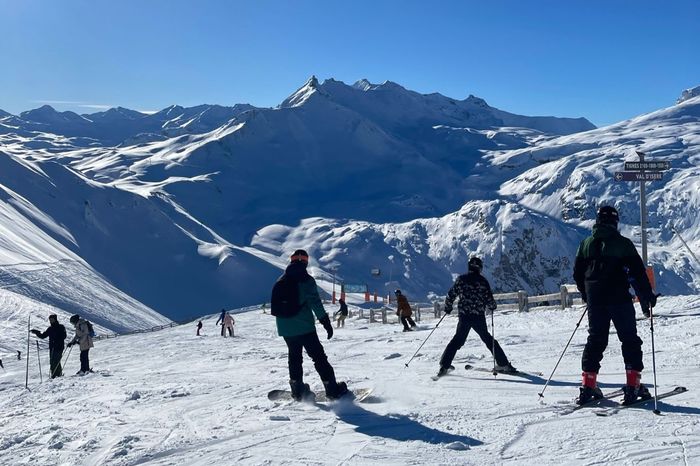Cambridge’s forgotten winter sports traditions
Caitlin Norman explores some of Cambridgeshire’s festive sports and how you can get involved with them

The end of Michaelmas term sees swathes of students rushing off on the Varsity trip, hoping to enjoy the delights of skiing and snowboarding - winter sports which, unfortunately, the UK is poorly equipped to offer. Cambridge lacks both mountains and (most of the time!) snow, meaning that those looking to engage in festive sports tend to have to travel abroad. However, for those like me who have neither the time nor the money to spend a week in the Alps, here are some festive sporting traditions closer to home.
“Should the ice crack, the only danger is getting soggy feet”
Fen skating is a form of ice skating specific to the East Anglia region and named after the Fens which allow the practice to happen. For much of the UK, the weather does not usually get cold enough to freeze over large lakes to the point that they become safe to skate on. In Cambridge and East Anglia, however, the geography of the local fens provides an alternative solution. The land around Cambridge is very flat and formed of meadows and rivers which flood easily. In the cold weather, these flooded fens can freeze, forming flat sheets of ice. Unlike large frozen lakes, should the ice crack, the only danger is getting soggy feet - a far cry from getting pulled under the ice and potentially drowning. The nature of the fens also means that the freezing process is faster and more frequent than in many parts of the country.
“The joy of this particular sport is its simplicity and accessibility”
During these frosty winters, people would create makeshift ice skates and take advantage of the frozen fields. The practice dates back to at least the medieval period, from which time skates made of sharpened animal bones have been found. Over time, metal runners became more commonly used, which could be tied to shoes using strings, or even screwed into boots. Fen skating was at its most popular during the 19th century, when racing was common and became something of a spectator sport. Competitors would race for a prize pot which was generally raised by the organisers of the matches and could consist of money, food or clothes. Match results would also often be published in local papers, with some racers gaining decent fame for their skill. While milder winters make fen skating less common than it once was, the joy of this particular sport is its simplicity and accessibility - whether you want to DIY some skates and get involved or simply watch the fun from the sidelines.
The one limitation of fen skating is, of course, the weather conditions, but even this is not a problem for another local tradition - Molly dancing. A form of Morris dancing which originated in East Anglia, Molly Dancing was traditionally performed by ploughboys during the winter months when the ground was too hard for farm work. Finding themselves out of a job but still wanting to earn some money over the Christmas season, the dancers would dress up and perform for tips. At least one - but often many - of the dancers would dress up as women, and this is possibly why the term ‘Molly’ became used for this style of folk dance. Dancers would also paint their faces as a disguise, possibly because the practice was seen as a form of begging, but also because they didn’t want to be identified while dressed as women.
The tradition experienced a revival in the 1970s, however very few of the original dances had been recorded so many modern Molly dances have been constructed from the little information still available. New dances have also been written which, like the originals, try to mimic the dances of the aristocracy, including features such as processing up or down a line and mirroring actions as pairs. Like the dances, the accompanying tunes used are fairly simple and can be picked up easily, as they were designed to be played by ear on instruments like the accordion or tin whistle. All of this makes Molly dancing a very accessible sport for anyone to get into. Modern Molly sides perform year-round, but many still do something special for Plough Monday - the start of the agricultural year - which, along with Boxing Day, was a traditional dancing day. Even for those who don’t want to get involved with dancing or playing music, Molly dancing is highly entertaining to watch, and anyone interested can experience it firsthand at the Whittlesea Straw Bear festival in Cambridgeshire this January.
 News / Cambridge launches plan to bridge ‘town and gown’ divide27 October 2025
News / Cambridge launches plan to bridge ‘town and gown’ divide27 October 2025 Arts / Reflections on the Booker Prize 202528 October 2025
Arts / Reflections on the Booker Prize 202528 October 2025 News / SU referendums heat up as campaigners claim intervention29 October 2025
News / SU referendums heat up as campaigners claim intervention29 October 2025 News / SU announces vote on NUS affiliation17 October 2025
News / SU announces vote on NUS affiliation17 October 2025 Film & TV / Finding space in Cambridge for the love of filmmaking29 October 2025
Film & TV / Finding space in Cambridge for the love of filmmaking29 October 2025










